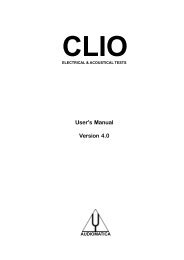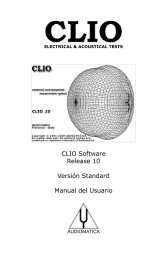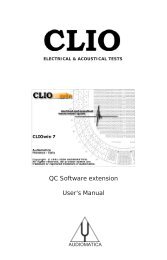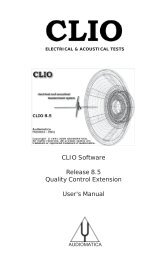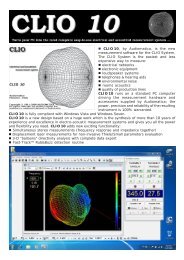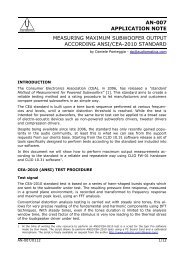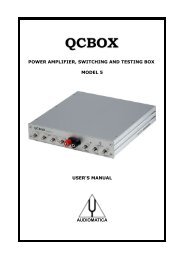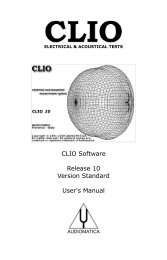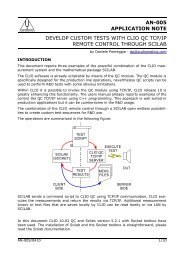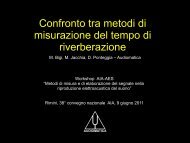CLIOwin 7 PCI User's Manual - Audiomatica
CLIOwin 7 PCI User's Manual - Audiomatica
CLIOwin 7 PCI User's Manual - Audiomatica
You also want an ePaper? Increase the reach of your titles
YUMPU automatically turns print PDFs into web optimized ePapers that Google loves.
life harder even if more interesting. Deriving the principals T&S Parameters from the five<br />
curves yields to Table 13.1<br />
Fs Qms Qes Qts<br />
+10dBu 69.244 3.105 0.609 0.5094<br />
+5dBu 71.63 3.6461 0.6643 0.5619<br />
0dBu 72.9912 3.986 0.695 0.5920<br />
-5dBu 73.5429 4.1663 0.7147 .61<br />
-10dBu 73.82 4.227 0.7218 0.6166<br />
Table 13.1<br />
Values from 0dBu to -10dBu are in optimum agreement and this sets the maximum<br />
level to be used to 0dBu. Interestingly enough, Internal Mode is less sensitive to output<br />
level. We will go further into this topic relying on CLIO being a complete and powerful<br />
audio measuring system. Without changing connections we will use CLIO’s FFT and<br />
Signal Generator to evaluate the distortion current at resonance at 10dBu. Fig.13.5<br />
shows the spectrum in this condition. The second harmonic is 56dB lower than the<br />
fundamental, which is 0.158% distortion. Even at 10dBu we are easily in the linear region<br />
of the loudspeaker motor. However what we have seen above, clearly states 10dBu<br />
is quite a high level for this device.<br />
-10.0<br />
CLIO<br />
dBV<br />
-30.0<br />
-50.0<br />
-70.0<br />
-90.0<br />
-110.0<br />
0.00 100 200 300 400 500 600 700 800 Hz 900 999<br />
Figure 13.8<br />
The reader could be tempted to determine the absolute quality of the device by means<br />
of this procedure. While he or she may be right, a lot of experience is needed. One<br />
important parameter, for reliable comparison among devices, is the value, in VRMS, at<br />
the speaker terminals at resonance. It is shown from FFT as -10dBV that is 0.316VRMS.<br />
13.3.3 DEALING WITH ENVIRONMENTAL NOISE<br />
The next problem in measuring loudspeaker impedance is noise. Transducers do their<br />
job in both directions and noise will appear as voltage exactly where CLIO’s input is<br />
connected. To evaluate the problem we deliberately produced a disturbance by<br />
generating a 110Hz single tone causing 58 dBSPL at the speaker cone. We took two<br />
impedance curves in this condition one with MLS the second with Sinusoidal. Both were<br />
160 Chapter 13 - Measuring impedance and T&S parameters



